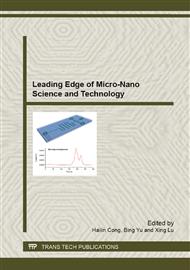[1]
E.T. Swartz and R.O. Pohl, Thermal boundary resistance, Rev. Mod. Phys. 61 (1989) 605-668.
DOI: 10.1103/revmodphys.61.605
Google Scholar
[2]
G. Balasubramanian, S. Banerjee and I. K. Puri, Unsteady nanoscale thermal transport across a solid-fluid interface, J. Appl. Phys. 104 (2008) 064306(4pp).
DOI: 10.1063/1.2978245
Google Scholar
[3]
T.W. Zhang, F. Ma, W.L. Zhang, D.Y. Ma, K.W. Xu and P.K. Chu Diffusion-controlled formation mechanism of dual-phase structure during Al induced crystallization of SiGe, Appl Phys Lett 100 (2012) 071908(3pp).
DOI: 10.1063/1.3685712
Google Scholar
[4]
D.G. Cahill, W.K. Ford, K.E. Goodson, G.D. Mahan, A. Majumdar, H.J. Maris, R. Merlin and S.R. Phillpop, Nanoscale thermal transport, J. Appl. Phys. 93 (2003) 793-818.
DOI: 10.1063/1.1524305
Google Scholar
[5]
L.B. Freund and S. Suresh, Cambridge University Press, Cambridge, UK (2003).
Google Scholar
[6]
D. Josell, T.P. Weihs and H. Gao, Diffusional creep: stresses and strain rates in thin films and multilayers, MRS Bull 27 (2002) 39-44.
DOI: 10.1557/mrs2002.18
Google Scholar
[7]
D. Weiss, H. Gao and E. Arzt, Constrained diffusional creep in uhv-produced copper thin films, Acta mater. 49 (2001) 2395-2403.
DOI: 10.1016/s1359-6454(01)00168-9
Google Scholar
[8]
P.A. Flinn, D.S. Gardner and W.D. Nix, Measurement and interpretation of stress in aluminum-based metallization as a function of thermal history, IEEE Trans. Electr. Dev. 34 (1987) 689-699.
DOI: 10.1109/t-ed.1987.22981
Google Scholar
[9]
M.D. Thouless, K.P. Rodbell and C.J. Cabral, Effect of a surface layer on the stress relaxation of thin films, J. Vac. Sci. Tech. A 14 (1996) 2454-2461.
DOI: 10.1116/1.580036
Google Scholar
[10]
M. Takagi, Electron-diffraction study of liquid-solid transistion of thin metal films, J. Phys. Soc. Jpn. 9 (1954) 359-363.
DOI: 10.1143/jpsj.9.359
Google Scholar
[11]
N.T. Gladkich, R. Niedermayer and K. Spiegel, nachweis grober schmelzpunkt serniedrigungen bei dünnen metallschichten, Phys. Status Solidi B 15 (1966) 181-192.
DOI: 10.1515/9783112492505-017
Google Scholar
[12]
N.T. Gladkich, S.I. Bogatyrenko, A.P. Kryshtal and R. Anton, Melting point lowering of thin metal films (Me = In, Sn, Bi, Pb) in Al/Me/Al film system, Applied Surface Science 219 (2003) 338-346.
DOI: 10.1016/s0169-4332(03)00707-4
Google Scholar
[13]
M.D. Thouless, J. Gupta and J.M.E. Harper, Stress development and relaxation in copper films during thermal cycling, J. Mater. Res. 8 (1993) 1845-1852.
DOI: 10.1557/jmr.1993.1845
Google Scholar
[14]
H.J. Frost and M.F. Ashby, Deformation-mechanism Maps. (Pergamon Press, Oxford) (1982).
Google Scholar
[15]
G.B. Gibbs, Diffusion creep of a thin foil, Phil. Mag. 13 (1966) 589-593.
Google Scholar
[16]
M.J. Thouless and C.V. Thompson, The thickness dependence of the ow stress of capped and uncapped polycrystalline ag thin film, Appl. Phys. Lett. 73 (1998) 2429-2431.
DOI: 10.1063/1.122471
Google Scholar
[17]
R.M. Keller, S.P. Baker and E. Arzt, Quantitative analysis of strengthening mechanisms in thin cu flms: effects of flm thickness, grain size, and passivation, Acta mater. 47 (1999) 415-426.
DOI: 10.1557/jmr.1998.0186
Google Scholar
[18]
Banerjee A and Hancock J W, The role of constraint in the fields of a crack normal to the interface between elastically and plastically mismatched solids, 2004 J. Mech Phys Solids 52 1093-1108.
DOI: 10.1016/j.jmps.2003.09.001
Google Scholar
[19]
J. Sumpter and J.W. Hancock, 10th European Conference on Fracture, Berlin, Germany, 1994, 617-626.
Google Scholar
[20]
Y.J. Kim, G.Y. Lin, A. Cornec and K.H. Schwalbe, Mechanical behaviour of austenitic steel 316L mod. specimens with incipient cracks,. Int.J. Fract. 78 (1996) 21-28.
Google Scholar
[21]
R. Khare, P. Keblinski and A. Yethiraj, Molecular dynamics simulations of heat and momentum transfer at a solid-fluid interface: Relationship between thermal and velocity slip, Int. J. Heat Mass Transfer 49 (2006) 3401-3407.
DOI: 10.1016/j.ijheatmasstransfer.2006.03.005
Google Scholar
[22]
B. Ganesh, B. Soumik and K.P. Ishwar, Unsteady nanoscale thermal transport across a solid-fluid interface, J. Appl. Phys. 104 (2008) 064306(4pp).
Google Scholar
[23]
H.L. Sun, Z.X. Song, F. Ma, J.M. Zhan and K.W. Xu, Microstructure, formation mechanism and compression plasticity of regularly faceted Cu particles, Scripta Materialia 60 (2009) 305-308.
DOI: 10.1016/j.scriptamat.2008.10.027
Google Scholar
[24]
O. Nast and S.R. Wenham, Elucidation of the layer exchange mechanism in the formation of polycrystalline silicon by aluminum-induced crystallization, J. Appl. Phys. 88 (2000) 124-132.
DOI: 10.1063/1.373632
Google Scholar
[25]
Z.M. Wang, J.Y. Wang, L.P.H. Jeurgens, and E.J. Mittemeijer, Thermodynamics and mechanism of metal-induced crystallization in immiscible alloy systems: Experiments and calculations on Al/a-Ge and Al/a-Si bilayers, Phys. Rev. B 77 (2008).
DOI: 10.1103/physrevb.77.045424
Google Scholar
[26]
W.J. Yu, Y.J. Zhang and Q.L. Ye, Spontaneous formation of ordered patterns in Al films deposited on silicone oil surfaces, Phys. Rev. B 68 (2003) 193403(4pp).
DOI: 10.1103/physrevb.68.193403
Google Scholar


